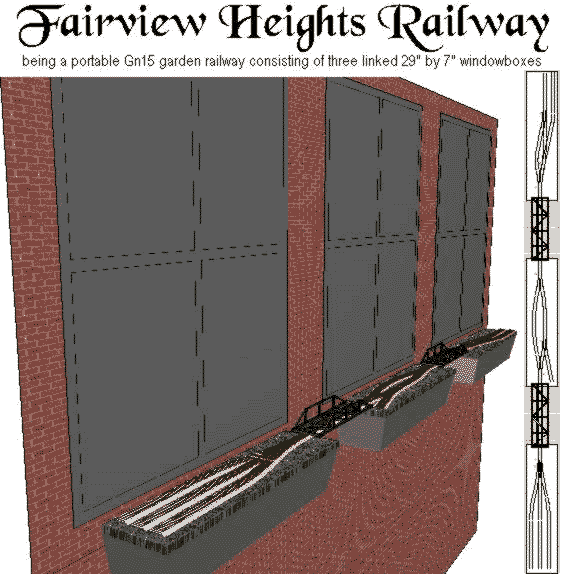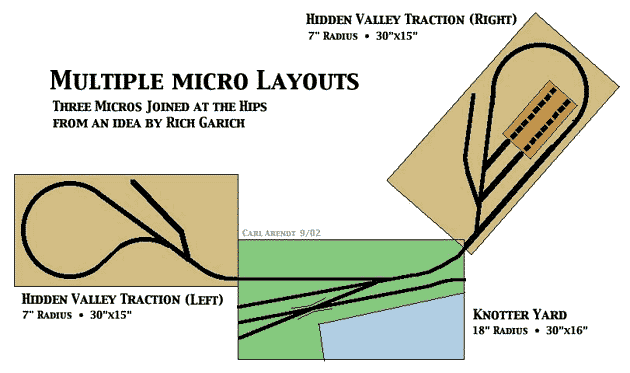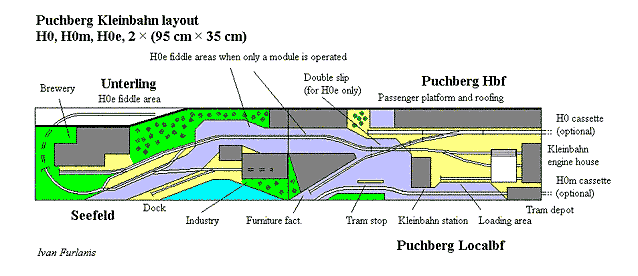Multiple Micros
Several readers have noted that a number of micro layouts could be connected, like dominoes, to form a larger “super-micro” layout. My feelings about this idea are mixed, as the essence of micro layout design is to produce very small, self-standing layouts. On the other hand, if a number of self-standing pikes could be easily connected to form a larger whole … that’s not only a design challenge, it’s a very interesting variation on our theme of small-sized operations. Here is a collection of examples.
Garden Railroading in Window Boxes
 In the Fairview Heights Railway, Emrys Hopkins designed a Gn15 version of a micro layout in a window box — or, in this case, three linked micro layouts in three window boxes. This little tramway runs from A to B to C, and can even meet and pass other trains en route!
In the Fairview Heights Railway, Emrys Hopkins designed a Gn15 version of a micro layout in a window box — or, in this case, three linked micro layouts in three window boxes. This little tramway runs from A to B to C, and can even meet and pass other trains en route!
Three operators, one at each window, can pass trains along the line in thoroughly prototypical fashion. Obviously, if you only have two windows, you can omit the center window box and operate a two-station point to point railway. For a one-window situation use the bottom box and extend the single track end of the three-way turnout, converting this little plan into a version of Morna Yard.
As an operating tip, Emrys suggests installing netting beneath the entire setup if you live above the ground floor.
 Rich Garich pointed out that several layouts from this Gallery and elsewhere could readily be joined together into a larger, coherent operating railroad. He suggested separating the two halves of the Hidden Valley Traction Co. and placing Knotter Yard (by Emrys Hopkins, from the Gn15.info website) between them. One possibility is shown above and might, as one wag suggested, be called the Knotter Lone Railway.
Rich Garich pointed out that several layouts from this Gallery and elsewhere could readily be joined together into a larger, coherent operating railroad. He suggested separating the two halves of the Hidden Valley Traction Co. and placing Knotter Yard (by Emrys Hopkins, from the Gn15.info website) between them. One possibility is shown above and might, as one wag suggested, be called the Knotter Lone Railway.
Minimum radius for the Hidden Valley portion has been increased to 7 inches, so HO trolleys/trams, O9 or O16.5 trains, or large-scale Gn15 industrial trams can ply the rails. The result is three 30” (76 cm) layout segments, with one of them placed at an odd angle to add spectator interest. If you like straighter lines — or want to occupy standard exhibition-hall folding tables — connect the right-hand segment to the next track down, and it will align nicely with the Knotter Yard segment.
Rich also had in mind a learning curve for small-layout building. Here are his construction notes for those who begin with the intention of connecting these micros: “Knotter Yard would be built first as a place to play and store rolling stock while building up the capital assets. No serious rail bending or track fabrication would be required [as only commercial track sections are used].
“Left side loop would be built second as a place to learn about scenery, reverse loop wiring, rail bending, bridge building and one essential scratch built turnout ( if feeling adventurous, do the other one too ) using previously bent rail pieces. [This two-segment arrangement provides an out and back layout.]
“Right side loop next with a larger building and more turnout practice allows continuous running for a display layout. With three segments in place we have a ‘Nucleus Railroad’ that can be easily moved for exhibition purposes and then reassembled into the major railroad when you get back home.”
Note that this is not the same as a modular railroad — both these two micro layouts remain usable as individual entities, but they can also be combined to form a larger operating layout when the occasion calls for such an arrangement.
Dual Gauge and Double Baseboards
 Ivan Furlanis, an Italian trolley and train enthusiast, designed the Puchberg Kleinbahn to be two independent micro layouts that can be operated individually or joined to form a larger railway. Each section measures 95×35 cm (37.4″x13.75″)–a dimension chosen to fit each section on a shelf in ivan’s bookcase. Ivan describes his design this way:
Ivan Furlanis, an Italian trolley and train enthusiast, designed the Puchberg Kleinbahn to be two independent micro layouts that can be operated individually or joined to form a larger railway. Each section measures 95×35 cm (37.4″x13.75″)–a dimension chosen to fit each section on a shelf in ivan’s bookcase. Ivan describes his design this way:
“This layout depicts a small, fictional German diesel or steam light railway (or an interurban tramway) between Puchberg and Unterling. This line is H0e [1:87 scale on 9mm gauge], and in Puchberg it interchanges with DB [German national railway] strandard gauge network. Between Puchberg and its suburb, Seefeld, the track is dual-gauged to permit standard gauge freight cars to reach the brewery that stands in Seefeld. There is no need of complicated dual-gauge switches, as the third rail for standard gauge cars doesn’t intersect other rails.
“The right section is Puchberg, inspired by Giles Barnabe’s German Tramway/Railway Interchange. On the backscene is the Puchberg Hbf DB station, of which only the outer platform is modeled. This small terminal has a transfer table [traverser] to complete the runaround track, and includes a three-track engine house and a loading area to transfer freight between trains and trucks. The transfer table must be long enough to hold an engine coupled to a car.
“There is a siding to a furniture factory that receives wood from a sawmill in Unterling [the hidden fiddle track]. To the left the mainline dual-gauge track is obscured by the furniture factory, so it can be used as a fiddle area if the second section is not yet built.
“In the foreground is the Puchberg Localbahnhof, served by a small H0m [1:87 scale on 12mm gauge] track where it is possible to run a small city tram [trolley] between the depot on the right and the stop in front of the Kleinbahn station. The depot can have the back wall opened to link it to a small cassette. However if a third gauge is too much effort for your taste, the tramway can be eliminated and its track can be paved over!
“The left section is Seefeld. The track plan is very similar to John Allen’s Timesaver, but here the brewery siding is dual gauged. There is a small wharf scene, the brewery and another industry. Then the mainline enters a tunnel and arrives in Unterling, the fiddle area. The unnamed industry hides the mainline, as the furniture factory does in the right section, so there is a second fiddle area for use if only this section is operated.
“Standard gauge cars arrive at and depart from the brewery pulled by Kleinbahn [narrow gauge] engines. The coupler is a bar with two rings that fit in the points of the classic H0 couplers. Once a similar service (standard gauge freight cars moved by narrow gauge engines) existed in Domodossola, Italy.
“On the Kleinbahn two trains can run in opposite directions meeting in Seefeld. There are lots of switching activities on the various industrial spurs. Switching action is also possible on the standard gauge because a two-axle diesel engine and a short two-axle freight car fit on the brief lead track [head shunt] at the right rear, and they can switch back from the standard gauge stub track on the left to the dual gauge section. A cassette will help this operation, allowing a short passenger train to stop on the platform, too. The minimum radius of the dual gauge tracks is 350 mm [13.75″], with a radius of 150 mm [6″] on H0e.”
Some operating variations, Ivan notes, might include a standard-gauge turn to serve the brewery, ducking along the narrow-gauge mainline between scheduled trains. Or you could omit the dual-gauge trackage entirely and carry the standard gauge cars on special narrow-gauge flat cars — or simply change out the trucks [bogies] as was done on a number of English and U.S. narrow gauge lines.
There are lots of possibilities, and a wide variety of operations are possible on this clever layout, which can be set in nearly any country in the world. You can build and operate either half or the entire 190×35 cm [75″x13.75″] shelf! For more information and a raft of photos and maps of Italian trams, visit Ivan’s website.